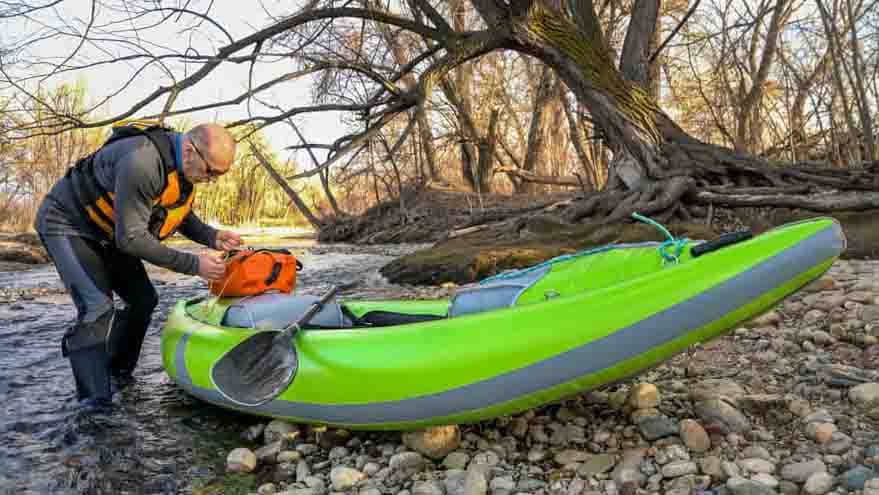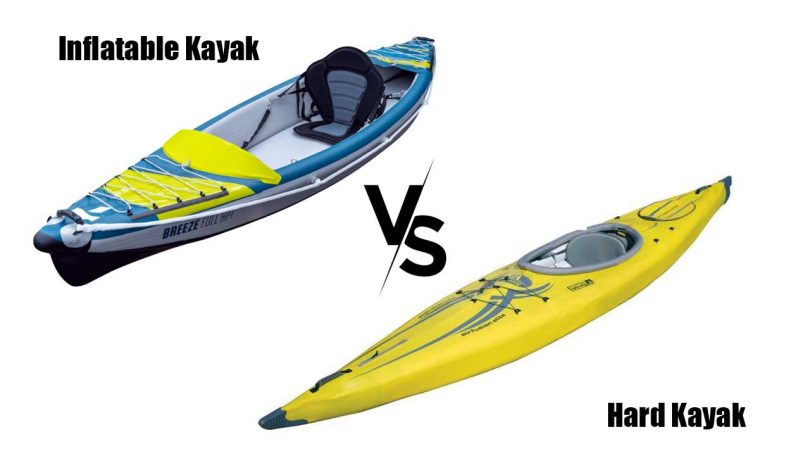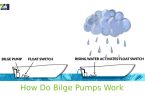The experience of riding in the river with either an inflatable or hard kayak is often thrilling. Do you love seeing people paddling with their kayaks? Luckily, you feel like joining them but you’re confused about which kayak to choose. Keep calm, we’re here to help you.
We’re going to treat this inflatable vs hard kayak debate by answering most of the questions that will help you.
Inflatable vs Hard Kayak: What’s the Difference?
Materials
Hard kayaks are from different materials like fiberglass, polyethylene, wood, and composite. They are hard and rigid. Their material of construction plays a major role in its durability, weight, and price. For example, polyethylene kayaks are the least expensive but very durable. But, polyethylene is very heavy and can be damaged by the sun’s rays.
Inflatable kayaks are made from materials like PVC, Hypalon, Nitrylon, and Polyurethane. PVC kayaks are the cheapest. Besides, their damaged spots are easy to repair. But PVCs are easily damaged by exposure to UV rays. Hypalon and polyurethane inflatable kayaks are the most durable but also very expensive.
Transportation
Discussing transportation in inflatable kayaks vs hardshell kayaks? Here’s what we got. Hard kayaks are a little difficult to handle because of its weight and size. In fact, hardshell kayaks are often moved on roof racks or trailers. It’s difficult to lift up or take down a hard kayak to and from the roof rack without a helper.
But, inflatable kayaks are very easy to transport. They weigh about 30 to 40 pounds or less. You can fold it into bags and packed into the car trunk with ease.
Set Up
It takes some time and effort to load the hard kayak to your roof racks. But on getting to the water, you’ll only take it down from the rack and start paddling.
Setting up an inflatable kayak is easier. You’ll fold the inflatable kayak into your car and set out for the river. But on reaching the water, you’ll fill it with air before putting it in the water. This usually takes about 5 to 10 minutes. The only drawback is that most people are uncomfortable with the time spent to inflate the kayak.
Maneuverability
When comparing kayak inflatable vs hardshell by maneuverability, hardshell wins the day. This is because hardshell kayaks are a little more in the water. Also, its heavier than kayak inflatables making it more steady in the water. Hardshell kayaks are a bit narrower. Thus, you can lean to one side and then maneuver the kayak towards any direction.
If you’re paddling an inflatable kayak in calm water like a pond or lake, you’ll have no problem steering it. But the challenge will be much if you’re trying to navigate through fast-moving water.
Cost
Hard kayaks are expensive. This is because of the cost of its construction material like wood and fiberglass. Besides, you’ll spend more to maintain wooden hardshell kayaks.
For cost, inflatable kayaks are cheaper. You’ll find those high-quality materials like polyurethane which are resistant to puncture. These ones with high-quality construction cost more but are dependable and durable.
Portability

Hardshell kayaks are heavy because of their material of construction. Sometimes they’re two to three times heavier than an inflatable kayak. The lightest among the hard kayak is the composite hardshell. Yet, it’s still heavier than the heaviest inflatable kayak. The heaviest hard kayak is the tandem kayaks. These you carry with a cart only. Although the composite kayak is the lightest, you’ll need help to load and unload it from the roof rack.
The inflatable kayaks are very portable. In fact, children can carry them around. As we mentioned earlier, you can fold them into bags when deflated. Besides, you will not need to install a roof rack in your vehicle to transport it.
Storage
Hard fishing kayaks are bulky making it difficult to store. This shouldn’t be a problem because you can place it in your garage or basement. You shouldn’t leave your hard kayak on the floor or lean it against the wall. Rather, getting a kayak rack will be good or suspend it through some ropes attached to the ceiling.
Meanwhile, inflatable kayaks are easier to store. It is the best option if you’re living in a single apartment. In fact, you can keep it at any location in your home. The good thing is that you’ll deflate it to shrink its size. After which, you’ll place them in storage bags to be in shelves or under the bed. It’s important to protect your inflatable kayak from rodents, dust, and mold.
Reliability
When debating about reliability in inflatable vs hard kayak, then anything rigid wins. Hard kayaks are not easily damaged and they’re safe on rock surfaces.
Some of the best inflatables are from tough materials yet they get punctured. You’ll be mindful on the surface you’re launching it into the water. If they’re covered with sharp rocks, it might damage your inflatable kayak.
Size
Hard kayaks are about 9 feet or longer in length. This is one of the reasons you’ll need a roof rack on your vehicle to transport it to the beach. Besides, they’re heavy making it difficult to carry around.
Yet, inflatable kayaks can be folded to a duffel bag’s size which can fit the trunk of your car. They’re much smaller in size and weigh much less than the hard kayak. As such, they’re easy to store and carry.
Maintenance
Hard kayaks do not need much maintenance. If it’s a wooden kayak, then you’ll need to protect it from insects and rodents.
You’ll need to inflate and deflate your kayak inflatable before and after use. Most inflatables take about 5 to 10 minutes to inflate. You should be careful to prevent it from puncturing. Yet, some inflatables can withstand puncture and leakage, but these are expensive. It’s important to dry your inflatable kayak before storage.
Durability
The durability of a hard kayak varies with its material of construction. Hardshell kayaks are of wood, fiberglass, composite, and plastic materials. Some hard kayaks will last for a lifetime even with little or no maintenance.
Some inflatables can withstand puncture and leakage which makes it durable too. What you’ll get depends on its price. This implies you’ll find a durable inflatable kayak if you’re willing to pay the money. Despite this, you should keep it away from rocky surfaces.
Weight
Generally, hard kayaks are heavy. Although some are heavier than others depending on the material of construction.
But, inflatables are lightweight since they’re made of rubber. They can be easily carried from the storage place to the beach and vice versa.
Safety Concerns

Hard kayaks are very narrow which makes them prone to tipping. This can be a very dangerous experience in the water.
Inflatables are safer since they’re a little wide and are less likely to capsize. The only issue of a safety concern with an inflatable kayak is puncturing and leakage. But, the expensive ones are with safety measures to withstand puncture to an extent.
Comfort
You may not like the hard surface of the hardshell kayak while you’re sitting on it. Such feeling of discomfort will reduce you’re paddling time making you return home sooner.
Inflatable’s surfaces feel very soft while sitting. Besides, you’ll not experience numbness or pains when sitting on it. Also, some inflatables come with a back seat that you can rest your back while paddling.
Performance
About performance in inflatable vs hard kayak, you’ll find that both has its pros and cons. For instance, hard kayaks are fast and easy to maneuver. Besides, they can withstand tough winds in the water. This means that hard shells are more suitable for ocean rides.
Yet, inflatable kayaks are stable and do not capsize easily. But because of their lightweight, you may experience some difficulty controlling it.
Inflatable Kayaks vs Hardshell Kayaks: The Winner
Hard kayaks are durable especially polyethylene kayaks. They can launch from rocky beaches without a tear. And if you’re planning to paddle in stony waters, it’s the right choice. Hard kayaks are bulky which means you can keep some of your fishing gear in the unused spaces.
Inflatable kayaks are cheaper making it an excellent choice if you’re on a low budget. If you’re new to paddling with intentions to enhance your skills, you should opt for an inflatable kayak. This is because you’ll enjoy its comfort, ease of storage, and transportation. Besides, some of the best inflatable kayaks are from polyurethane and Hypalon materials. It means that inflatables are reliable and long-lasting too. Since they’re yet rubber and fabric, the risk of puncturing when it crashes against a sharp surface is still there.
Conclusion
It is difficult to state the winner in the inflatable vs hard kayak debate because each has its pros and cons. The truth is that your preference should determine your ideal kayak.
It is important for you to make some research to know the type of kayak you need before making the buy.








Leave a Comment